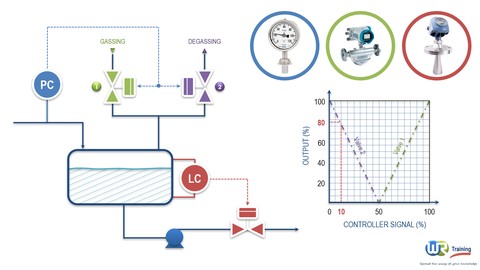
Introduction to process control and instrumentation
Introduction to process control and instrumentation, available at $64.99, has an average rating of 4.41, with 74 lectures, 1 quizzes, based on 2975 reviews, and has 10917 subscribers.
You will learn about Learn the essentials of process control and instrumentation for a successful career in process industries Understand the main terms and parameters of process control (Process variable PV, Set point SP, Operating point OP, Error, Offset, Load disturbance…) Identify the different control loops and describe their main tasks Describe the basic function & method of operation for the main control loop components (Transducer, Converter, Transmitter, Indicator, Recorder, Controller…) Given a piping and instrumentation drawing (P&ID), correctly identify, interpret and label the instrument, location and signal type symbols Differentiate between discrete, multistep, and continuous controllers Describe the general goal of controller tuning Describe the basic mechanism, advantages and disadvantages of the following mode of controller action : Proportional, Integral and Derivative Identify the basic implementation of P, PI and PID control in the following types of loops : Pressure, Flow, Level and Temperature loops Differentiate feedback and feedforward control loops Diagram the process control loop using ISA symbology Explain the basic implementation process for each of the following types of control : Cascade, Split range , Batch, Ratio and Selective controls Understand through extensive 3D animation the techniques and methods used in process industries to measure temperature, pressure, flow and level This course is ideal for individuals who are Personnel needing to learn the essentials of process control and instrumentation or Control, Process, Chemical and Design Engineers or Operation, technical service and maintenance professionals or Experienced personnel as a refresher course and to broaden their knowledge or Consultants and Sales professionals It is particularly useful for Personnel needing to learn the essentials of process control and instrumentation or Control, Process, Chemical and Design Engineers or Operation, technical service and maintenance professionals or Experienced personnel as a refresher course and to broaden their knowledge or Consultants and Sales professionals.
Enroll now: Introduction to process control and instrumentation
Summary
Title: Introduction to process control and instrumentation
Price: $64.99
Average Rating: 4.41
Number of Lectures: 74
Number of Quizzes: 1
Number of Published Lectures: 74
Number of Published Quizzes: 1
Number of Curriculum Items: 75
Number of Published Curriculum Objects: 75
Original Price: €99.99
Quality Status: approved
Status: Live
What You Will Learn
- Learn the essentials of process control and instrumentation for a successful career in process industries
- Understand the main terms and parameters of process control (Process variable PV, Set point SP, Operating point OP, Error, Offset, Load disturbance…)
- Identify the different control loops and describe their main tasks
- Describe the basic function & method of operation for the main control loop components (Transducer, Converter, Transmitter, Indicator, Recorder, Controller…)
- Given a piping and instrumentation drawing (P&ID), correctly identify, interpret and label the instrument, location and signal type symbols
- Differentiate between discrete, multistep, and continuous controllers
- Describe the general goal of controller tuning
- Describe the basic mechanism, advantages and disadvantages of the following mode of controller action : Proportional, Integral and Derivative
- Identify the basic implementation of P, PI and PID control in the following types of loops : Pressure, Flow, Level and Temperature loops
- Differentiate feedback and feedforward control loops
- Diagram the process control loop using ISA symbology
- Explain the basic implementation process for each of the following types of control : Cascade, Split range , Batch, Ratio and Selective controls
- Understand through extensive 3D animation the techniques and methods used in process industries to measure temperature, pressure, flow and level
Who Should Attend
- Personnel needing to learn the essentials of process control and instrumentation
- Control, Process, Chemical and Design Engineers
- Operation, technical service and maintenance professionals
- Experienced personnel as a refresher course and to broaden their knowledge
- Consultants and Sales professionals
Target Audiences
- Personnel needing to learn the essentials of process control and instrumentation
- Control, Process, Chemical and Design Engineers
- Operation, technical service and maintenance professionals
- Experienced personnel as a refresher course and to broaden their knowledge
- Consultants and Sales professionals
June 24 course update:
We have added new video lectures and quizzes to help you test your knowledge and emphasize the key learning points. The quiz will include:
-
True/False questions
-
Multi-choice questions
-
Images, cross-sectionnal views
-
Solved problems
-
and much more…
When you think you’ve got a good grasp on a topic within the course, you can test your knowledge by taking the quiz. If you pass, wonderful ! If not, you can review the videos and notes again or ask us for help in the Q&A section.
—
Dear student,
Control in process industries refers to the regulation of all aspects of the process. Precise control of level, temperature, pressure and flow is important in many process applications.
This course introduces you to control in process industries, explains why control is important, identifies different ways in which precise control is ensured and illustrates the different set of instrumentation used to perform measuring tasks for temperature, pressure, flow and level.
The course includes extensive graphics, cut sections, process schemes and 3D animationsto give you a virtual practical exposure on process control and instrumentation.
The objective of this course is twofold :
1.Break down for you all the process control and instrumentation principles into easily digestible concepts like feedback control, split range, controller tuning, transmitters, differential pressure gauges, etc…
2. Illustrate through 3D animations and cut-sections the main control instrument devices to measure temperature, pressure, flow and level like thermocouples, capacitive pressure gauges, coriolis flowmeters, etc…
As you proceed through the course, answer the questions in the attached pdf quiz files. These files are available at the end of each section.
We strongly advise you to do so before moving on in the course. Quiz exercises help you measure your progress toward meeting each section’s learning objectives.
If you pass, wonderful. If not, you can review the videos and notes again or ask us for help in the Q&A section.
So with no further ado, check out the free preview videos and the curriculum and we look forward to see you in the first section.
Also remember, as enrolled student you will have unlimited access to this material and one-on-one instructor support. So feel free to interact with us by email or simply ask us for help in the Q&A section. It will be our pleasure to help you and provide assistance.
Hope to see you there
Cheers,
WR Training
Spread the wings of your knowledge
Course Curriculum
Chapter 1: ABOUT THE COURSE
Lecture 1: Introduction
Lecture 2: Learning objectives
Chapter 2: THE IMPORTANCE OF PROCESS CONTROL
Lecture 1: The importance of process control : Learning objectives
Lecture 2: The process
Lecture 3: Process control
Chapter 3: CONTROL THEORY BASICS
Lecture 1: Control theory basics : Learning objectives
Lecture 2: The control loop
Lecture 3: Process control terms
Chapter 4: COMPONENTS OF CONTROL LOOPS AND ISA SYMBOLOGY
Lecture 1: Components of control loops and ISA symbology : Learning objectives
Lecture 2: Primary elements / sensors
Lecture 3: Transducers and converters
Lecture 4: Transmitters
Lecture 5: Signals
Lecture 6: Indicators
Lecture 7: Recorders
Lecture 8: Controllers
Lecture 9: Final control elements
Lecture 10: Actuators
Lecture 11: ISA symbology
Chapter 5: CONTROLLER ALGORITHMS AND TUNING
Lecture 1: Controller algorithms and tuning – Learning objectives
Lecture 2: Controller algorithms
Lecture 3: Why controllers need tuning
Lecture 4: Proportional mode (P)
Lecture 5: Integral mode (I)
Lecture 6: Derivative mode (D)
Lecture 7: P, PI and PID control
Chapter 6: PROCESS CONTROL LOOPS
Lecture 1: Process control loops – Learning objetcives
Lecture 2: Single control loops : Feedback control
Lecture 3: Pressure control loops
Lecture 4: Flow control loops
Lecture 5: Level control loops
Lecture 6: Temperature control loops
Lecture 7: Multi-variable loops
Lecture 8: Multi-variable loops : Feedforward control
Lecture 9: Feedforward + Feedback
Lecture 10: Cascade control
Lecture 11: Split range control
Lecture 12: Operations on control signals
Lecture 13: Ratio control
Lecture 14: Batch control
Lecture 15: Selective control
Chapter 7: INSTRUMENTATION : TEMPERATURE MEASUREMENT
Lecture 1: Introduction
Lecture 2: Local indicators
Lecture 3: Bulb instruments for remote transmission
Lecture 4: Thermocouples
Lecture 5: Resistance Temperature Detectors (RTDs)
Chapter 8: INSTRUMENTATION : PRESSURE MEASUREMENT
Lecture 1: Hydrostatic manometers
Lecture 2: Bourdon tube pressure gauges
Lecture 3: Bellows pressure gauges
Lecture 4: Strain pressure gauges
Lecture 5: Piezoelectric pressure gauges
Lecture 6: Capacitive pressure gauges
Chapter 9: INSTRUMENTATION : FLOW MEASUREMENT
Lecture 1: Orifice, Nozzles & Venturi tubes
Lecture 2: Pitot tubes
Lecture 3: Annular probes
Lecture 4: Rotameters
Lecture 5: Vortex flowmeters
Lecture 6: Ultrasound flowmeters
Lecture 7: Electromagnetic flowmeters
Lecture 8: Coriolis mass flowmeters
Chapter 10: INSTRUMENTATION : LEVEL MEASUREMENT
Lecture 1: Introduction
Lecture 2: Glass level gauges
Lecture 3: Float level gauges
Lecture 4: Float switches
Lecture 5: Reed chain float sensors
Lecture 6: Magnetic level gauges
Lecture 7: Hydrostatic level gauges
Lecture 8: Bubble tubes
Lecture 9: Optoelectronic switches
Lecture 10: Capillary systems
Lecture 11: Ultarsonic sensors
Lecture 12: Radars
Lecture 13: Radiometric sensors
Lecture 14: Bonus
Instructors
-
WR Training
Petroleum Petrochemical & Chemical Engineering
Rating Distribution
- 1 stars: 14 votes
- 2 stars: 52 votes
- 3 stars: 429 votes
- 4 stars: 1166 votes
- 5 stars: 1314 votes
Frequently Asked Questions
How long do I have access to the course materials?
You can view and review the lecture materials indefinitely, like an on-demand channel.
Can I take my courses with me wherever I go?
Definitely! If you have an internet connection, courses on Udemy are available on any device at any time. If you don’t have an internet connection, some instructors also let their students download course lectures. That’s up to the instructor though, so make sure you get on their good side!
You may also like
- Best Video Editing Courses to Learn in February 2025
- Best Music Production Courses to Learn in February 2025
- Best Animation Courses to Learn in February 2025
- Best Digital Illustration Courses to Learn in February 2025
- Best Renewable Energy Courses to Learn in February 2025
- Best Sustainable Living Courses to Learn in February 2025
- Best Ethical AI Courses to Learn in February 2025
- Best Cybersecurity Fundamentals Courses to Learn in February 2025
- Best Smart Home Technology Courses to Learn in February 2025
- Best Holistic Health Courses to Learn in February 2025
- Best Nutrition And Diet Planning Courses to Learn in February 2025
- Best Yoga Instruction Courses to Learn in February 2025
- Best Stress Management Courses to Learn in February 2025
- Best Mindfulness Meditation Courses to Learn in February 2025
- Best Life Coaching Courses to Learn in February 2025
- Best Career Development Courses to Learn in February 2025
- Best Relationship Building Courses to Learn in February 2025
- Best Parenting Skills Courses to Learn in February 2025
- Best Home Improvement Courses to Learn in February 2025
- Best Gardening Courses to Learn in February 2025






















